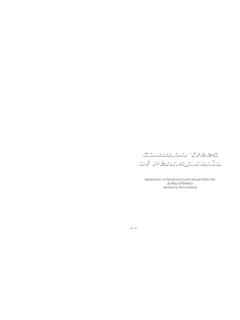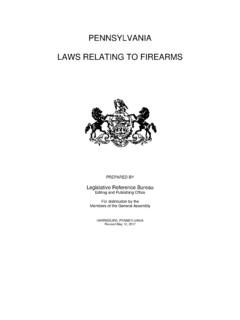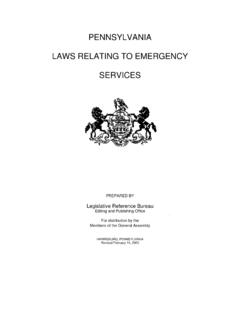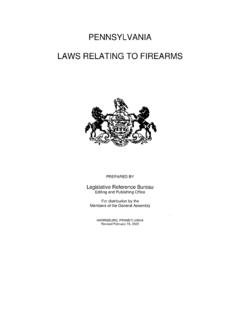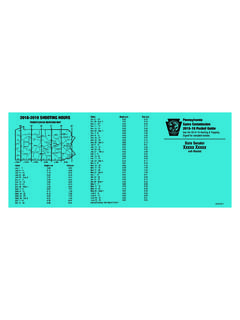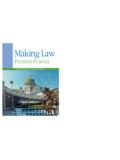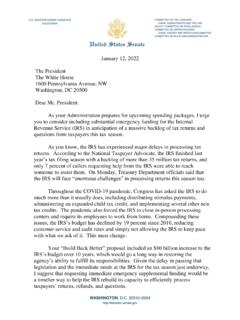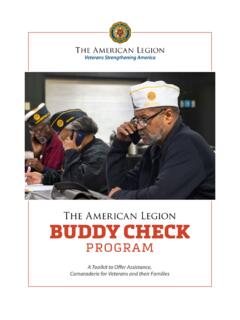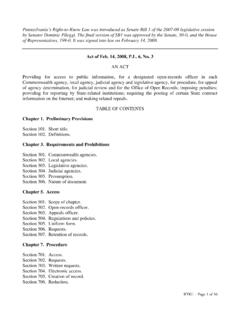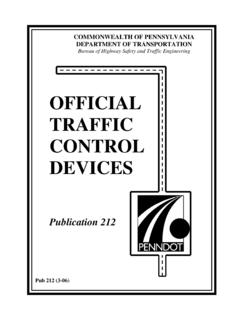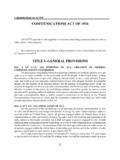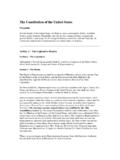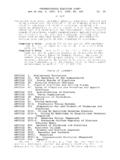Transcription of Welcome to the Senate of Pennsylvania
1 SENATEofPennsylvania Welcome to theHISTORYOFTHESTATECAPITOLThe first capital of Pennsylvania the headquarters ofPennsylvania s government was established at TinicumIsland, on the Delaware River in Bucks County, in 1643,when Pennsylvania was still a Colony. In the following years, the capital was moved toPhiladelphia and Lancaster before being permanentlyestablished in Harrisburg in 1812. A building was con-structed and the General Assembly first assembled thereon January 2, main building of the original Capitol wasdestroyed by fire on February 2, 1897. Two months later,the General Assembly authorized the construction of thepresent main Capitol building, which was dedicated byPresident Theodore Roosevelt on October 4, building was designed by Philadelphia architectJoseph M. Huston to reflect the architecture of theItalian Renaissance. An East Wing addition was con-structed in 1987 to alleviate space five-story Capitol, with its Vermont granite exteri-or, contains 475 rooms and covers two acres of the center is its landmark dome, 272 feet in height,topped by a symbolic figure of the Commonwealthholding a garlanded Capitol s interior is finished in marble, mahogany,bronze and tile.
2 Its corridors are adorned with gold leaffixtures and paintings from renowned artists. The interiorof the dome is a popular attraction for Capitol visitors,who are drawn to its breathtaking State Seal isstamped onto officialCommonwealth docu-ments to certify theirauthenticity. WhenPennsylvania was still aprovince of England, its sealswere those of William Penn andhis descendants. By 1778, a seal similar to the presentone was in use. The seal includes obverse and reverse faces, althoughthe obverse face is most commonly used. It contains ashield emblazoned with a sailing ship, a plow andsheaves of wheat. Surrounding the shield are a stalk ofIndian corn, an olive branch and the inscription, Sealof the State of Pennsylvania . The reverse face shows a woman representing liber-ty trampling upon a lion representing tyranny. Thedesign is encircled by the words, Both Can t Survive. THECOATOFARMSP ennsylvania s Coat of Arms is a symbol of theCommonwealth and can be found on many documentsand publications.
3 An early version first appeared onstate paper money issued in 1777; a revised designtoday adorns the state flag. The coat of arms was origi-nally designed by Caleb Lownes of Philadelphia morethan 200 years ago. The Legislature changed it severaltimes before settling on the current design similar toLownes original made up of a shield in the center,supported by two horses. On the shield are theemblems of the State Seal a ship, plow, sheaves ofwheat, an olive branch and cornstalk. At the bottom isthe motto Virtue, Liberty and Independence. Harrisburg has been the capital of Pennsylvania since main building of the original Capitol, pictured here, wasdestroyed by fire in 1897. About PennsylvaniaThe Pennsylvania General AssemblyBASICINFORMATIONABOUTTHELEGISLAT UREThe Legislature enacts laws, levies taxes and deter-mines how the funds from such taxes will be spent. Thestate appropriates money to support schools, hospitals,senior citizens and the poor; to build and maintainroads and bridges; and to fund the general cost of run-ning state Pennsylvania Legislature is made up of two elect-ed bodies, or chambers the Senate , with 50 members,and the House of Representatives, with 203 chambers must approve a bill before it can be sentto the Governor, who can either sign it into law or rejectit through the use of veto Senate alone also has the authority to approve orreject certain nominations made by the Governor toboards, commissions, judgeships, Senate Chamber is located in the Capitol s northwing and the House Chamber is in the south Lieutenant Governor, who is second-in-commandin state government to the Governor, also serves asPresident of the Senate , opening and closing the day sactivities, announcing bills up for vote and enforcingSenate rules.
4 In the occasion of a tie on certain issues,the Lieutenant Governor casts a Senate vote. In theabsence of the Lieutenant Governor, the President ProTempore elected to the post by fellow Senators pre-sides. The House is presided over by the Speaker, a memberof the House who is elected to the position by sessions begin on the first Tuesday in Januaryin each odd year and continue for two years until theLegislature formally recesses in a process called sinedie. Senate sessions are usually held on Monday,Tuesday and is no restriction on the subject matter of legisla-tion that may be considered in regular sessions are called by proclamation by theGovernor or by petition of a majority of members in theHouse and Senate . Only subjects mentioned in theproclamation can be considered in a special Senatorial District contains an average of245,621 people; each House District an average of60,498 assist Senators in their lawmaking and constituentduties each Senator employs a staff of secretaries andadministrative aides.
5 Staff members work with the Senator to answer con-stituent phone calls and letters; process requests and State Senatorial DistrictsAlleghenyRegionPhiladelphiaRegi onThe Senator s JobDuring any two-year legislative session, aSenator will consider hundreds of bills, takevotes on the Senate floor, consider the pas-sage of new laws, attend hundreds of meet-ings on government issues, assist in the development ofstate budgets, and reply to constituent letters, phonecalls and inquiries. These varied and diverse responsi-bilities fall under a Senator s three basic roles: lawmaker,supervisor of government operations, and constituentrepresentative. As a lawmaker, a Senator proposes new laws orchanges to existing laws. As a government supervisor,the legislator oversees the executive branch of govern-ment and its multi-billion dollar budget. As a con-stituent representative, a Senator acts as a liaisonbetween district constituents and state three roles are played out in various waysthroughout any given day, as explained Works with staff members to research the issuesinvolved in a bill the Senator will introduce or legisla-tion on which the Senator will vote.
6 Develops support for, or opposition to, legislationthrough meetings, telephone calls and written corre-spondence. Attends caucus meetings and hearings to becomeinformed on issues coming before the Senate . Serves as a member of various standing committees. Attends Senate sessions, takes part in debate, and voteson business before the Uses committee meetings, constituent input anddepartment reports to monitor the operation of stategovernment departments. Oversees development of Pennsylvania government sannual budget. Reviews all individuals nominated by the Governor forexecutive appointments to state boards, commissionsand departments for which Senate approval is Meets with constituents, fellow legislators and otherswho request that the Senator introduce, support oroppose legislation. Replies to correspondence and telephone calls fromconstituents. Keeps constituents informed on pending legislationthrough newsletters, television shows, and other out-lets, and requests that district residents share theirviews on issues through surveys.
7 Represents the Commonwealth or legislative district atceremonial state or local functions. Works to resolve constituent disputes and other for state government services; researchissues that will come before the Senate or committeeson which the Senator serves; provide information on theactivities of state agencies and departments; and coordi-nate activities in the Senator s Capitol and are several reference materials available toSenators and the general public to help track the thou-sands of pieces of legislation introduced each Calendar Placed on the desk of each memberevery day the Senate is in session, the calendar lists all thebills or executive nominations before the Senate that History A limited number of copies areprinted each week and delivered to each Senator s officeand filed on the Senate floor. The history shows every billand resolution introduced in the House and Senate , actiontaken, and the status of the legislation as it makes its waythrough the legislative also lists bills approved or vetoed by the Governor,committee action, and other information.
8 A final leg-islative history is published at the end of each sessionending in an even-numbered Journal A Senate and House journal isprepared daily recording all action and votes taken plusother pertinent information. These are printed formembers and distributed to libraries throughout theCommonwealth. 3 PROPOSINGLEGISLATIONP roposed new laws are known as bills until they areenacted , until they pass both chambers andbecome law. Any bill may begin in either the House orSenate except bills raising revenue, which must origi-nate in the an effort to provide adequate consideration of leg-islation, the state Constitution requires that a bill mustbe considered on three separate days in each of the Senate s important work is done in com-mittees. When a bill is introduced, it is printed for legis-lators and the public to view, and referred to the appro-priate legislative committee. For example, a bill thatwould affect public schools would ordinarily be referredto the Education Committee.
9 There are 21 permanent or standing committeesin the Senate . The committees may be broken into sub-committees by the chairman to handle more complexlegislation. The President Pro Temporeappoints the chairman, vicechairman and members ofeach Senate committee as wellas any special or temporarycommittee the Senate autho-rizes. Though the amount oftime a Senator has served inthe Senate is considered whenthe President Pro Temporemakes committee assign-ments, a Senator oftenrequests to serve on commit-tees that reflect the Senator sinterests or interests in majority of committeemembers a quorum must be present to conduct ameeting. All meetings areopen to the , on rare occasions,the committee may conductsome business in private orexecutive addition to voting on legislation, committees canhold public hearings on a bill or package of bills to gaininput from the public and interested parties. A commit-tee member, or anyone interested in the legislation, mayask the chairman to hold hearings.
10 Persons known tobe for or against a bill or who are recognized expertsrepresenting groups affected by the legislation are usual-ly notified of the hearings so they may are not required to approve or reportout legislation. One of the chief functions of commit-tees is to screen out undesirable or unnecessary billsbefore they reach the full Senate . However, the arbitraryrefusal of a committee to report a bill can be remedied bya motion to discharge the committee from further consid-eration of the bill. Such a motion requires a majorityvote of 26 in the Senate and cannot be made until afterthe committee has had the bill for 10 legislative the motion carries, the bill goes to the full Senatefor consideration. LEGISLATIONENACTEDIn most cases, a billbecomes law after it isapproved on three differentoccasions in the House andSenate and signed by theGovernor. However, a billcan also become law on itsown if the Governor fails tosign or veto the measurewithin 10 days of receiving the Governor vetoes abill, it is returned to theGeneral Assembly alongwith a letter stating theGovernor s objections to , a bill may beenacted over the Governor sveto with the approval oftwo-thirds of the membersof each Lawmaking Process 4 How a Bill Becomes a LawThe first step in lawmaking is for a Senator or amember of the House of Representatives tosubmit his or her ideas in writing to theLegislative Reference Bureau the bill-writingagency of the Legislature outlining what the legislatoris seeking through the proposed law.

